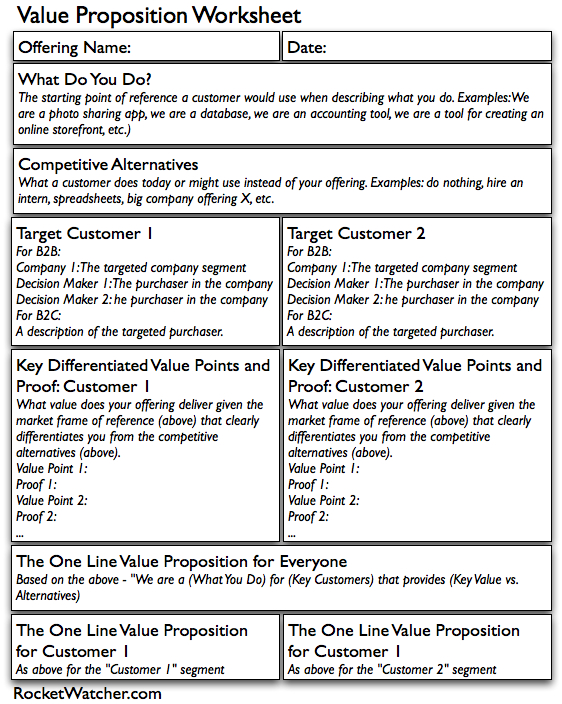Creating a great value proposition is a critical step in building good marketing messages but writing effective value propositions isn’t easy. Marketing schools still teach the standard for creating value propositions from Crossing the Chasm that looks like this:
For (bulls-eye customer), Who (purchase motivation), Our product is a (customer language), That (benefit), Unlike (competitors), Ours (differentiators), At a price (vs. competitors).
I wrote a post on this style of value proposition a while back and another on how you might craft a set of simple value statements. Lately however I’ve been thinking that there’s a step missing from the way we traditionally create these, namely the step that shows how you got to the value proposition in the first place.
Why a Value Proposition Worksheet?
Your value propositions will be based on a set of facts and assumptions. The assumptions will shift or become facts as you run experiments and execute on marketing programs. The facts will change too, as you evolve who your ideal target customers are, as new competitors enter the market, and as your own product changes with additional releases.
I’ve been using variations on the template (I sometimes refer to this an “offering template”) for a while and I think it works:
What Do You Do? – this is the simple statement that describes what you offering does. This isn’t the value you provide (that comes later) but rather the starting point of how you would frame what you do for someone you have never pitched before.
Competitive Alternatives – this is what a prospect would see as an alternative to using your offering. It could be “do nothing” or “hire someone” or “use Excel” or it could include an actual competing offering in some cases.
Target Customer 1, 2, 3,… – This section is for capturing a high-level description of who you are trying to market to. For B2B companies you need to think both about what types of businesses you are trying to reach along with the purchasers inside those businesses. For B2C you are focused here on segments of target consumers.
Key Differentiated Points of Value and Proof Points – For each target customer this section captures what the key differentiated (meaning clearly different from the competitive alternatives) points of value are and what proof points you have to back up that claim. For example if you say you are the fastest, best designed, most intuitive, etc. solution on the market, you need to think about how you can prove that using performance statistics, customer testimonials, 3rd party reviews, etc.
One Line Value Propositions – Lastly the template captures the value propositions. I like to have one over-arching one that applies across all of the target segments and then another set for each target segment.
What do you think? Is it missing anything?



Great worksheet April!
I’ve typically used something like this in the past:
1. Your target customer
2. Their need
3. Their frame of reference
4. Your dramatic difference(s)
5. Your reason(s) to believe
For (target customer), That Need (their need), Our Company/Product is (their frame of reference) that allows you to (dramatic difference(s)), with a (Your reason(s) to believe).
It is quite similar to what you have proposed above, with more or less the same building blocks; but different in that it fits well for companies that are trying to rebrand and/or reposition themselves as well. Points 3 and 5 are where I think the subtle differences exist.
Thanks again for the great worksheet. I’ll be sure to give it a go when refining product propositions in the future!
Cheers,
Amrita
Hey Amrita,
Yes, exactly! That’s a similar structure for the final value proposition itself (I particularly like the phrasing of “Your dramatic difference”).
I think the most important thing is that the thinking behind where the value prop. came from is captured so you can go back and tune it. This makes it a living worksheet rather than just a static document.
For example you might assume that the competitive alternatives for your product are a couple of solutions that exist in the market and then create your value proposition around your dramatic differences versus those products. Then later you might discover through working with customers that the biggest competitor is to actually use Excel or just have some cheap interns do it manually. That would naturally change your “dramatic difference” because how you are different from interns is probably something distinct from how you are different from another solution in your space. You need to capture that so that you can go back and tune this assumption. If the assumptions aren’t tracked there you might be tempted to just keep going with the value prop. you have even when the inputs have dramatically changed.
April, how does this compare to a positioning statement?
It depends on your definition but in my mind it’s essentially the same thing. The positioning statement is more explicitly oriented about describing how you compare to other alternatives – good ones will position around the value they deliver, so therefore it ends up looking just like a value proposition.
You can call it whatever you like in my mind but you will always need to have a lowest common denominator value statement for what your offering is and why your target segments should care. That’s what I’m getting at here.
April
I couldn’t have seen this post at a better time – what I really love is the consideration of more than 1 customer segment.
One of the things I continuously ask myself and team when we’re fine tuning our value statements is “WHY” – Why are we doing what we’re doing? Why are we building this? Why does it matter? I think it’s important part of “What we do” as well as a great frame of reference when reviewing differentiators against competitors and alternatives.
Hey thanks!
The “why” question is an important one. Overall I think companies don’t spend enough time honing their messaging, which doesn’t make sense considering it forms the basis of every marketing program the company is running.
April
Agreed! I also find with Startups, it’s very easy to get distracted when you’re getting so many different perspectives from advisors, mentors, influencers, and other entrepreneurs on what the “real value” of your product/service is.
Which is where worksheets like this come in handy!
Killer thanks